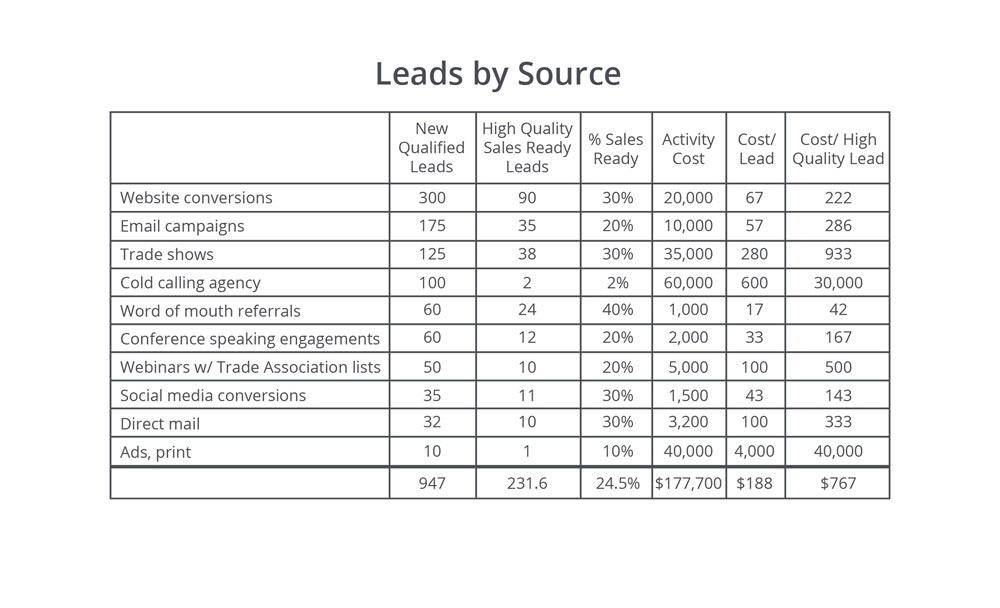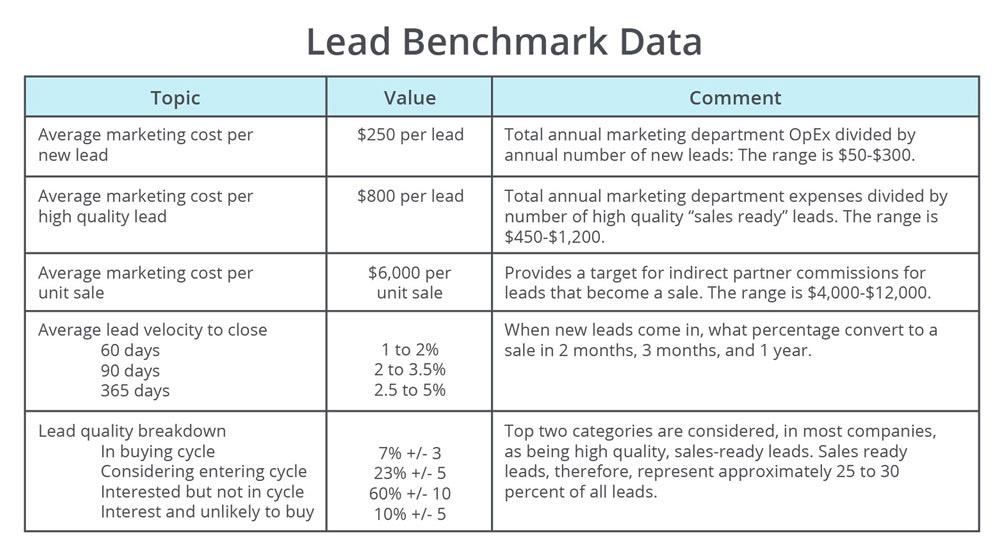Co-founder
- FMA
- The Fabricator
- FABTECH
- Canadian Metalworking
Categories
- Additive Manufacturing
- Aluminum Welding
- Arc Welding
- Assembly and Joining
- Automation and Robotics
- Bending and Forming
- Consumables
- Cutting and Weld Prep
- Electric Vehicles
- En Español
- Finishing
- Hydroforming
- Laser Cutting
- Laser Welding
- Machining
- Manufacturing Software
- Materials Handling
- Metals/Materials
- Oxyfuel Cutting
- Plasma Cutting
- Power Tools
- Punching and Other Holemaking
- Roll Forming
- Safety
- Sawing
- Shearing
- Shop Management
- Testing and Measuring
- Tube and Pipe Fabrication
- Tube and Pipe Production
- Waterjet Cutting
Industry Directory
Webcasts
Podcasts
FAB 40
Advertise
Subscribe
Account Login
Search
A best practices guide for generating leads
Digital marketing alternatives are great tools—if you know how to use them
- By Chip Burnham
- October 15, 2018
- Article
- Shop Management
Generating leads is easy, if the goal is modest. It’s often possible to simply rely on your reputation and website to bring in leads.
However, when business is down, these passive approaches aren’t enough. It’s time to touch your market proactively and inspire prospects to connect with you.
In a perfect world, manufacturers could automatically generate leads when they need them. They would throw the lever, have $1,000 come out of the marketing budget, and see 10 leads dropped into the customer relationship management (CRM) software database.
However, the reality is we don’t have a lever. Most of us are left feeling unsure of the return on investment (ROI). As a result, marketing is often underfunded and the lead generation underperforming.
Independent studies show six out of 10 business-to-business (B2B) marketers find generating high-quality leads their biggest challenge. And our own MarketMD™ Health Check, which focuses only on manufacturers agrees: Ineffective lead generation is the most common issue impeding growth, outpacing other important areas such as improving sales win rate and hitting profit goals. Finding leads you can convert into business is tough, but it’s not impossible—if you follow some basic steps.
Getting Started
When creating your lead-generation campaign, start with a strong foundation. Figure 1 drives home the point that before you search for more leads, make sure you’ve selected the best end markets to pursue, uncovered the needs of those end markets, and created messaging and content that resonates. Only then are you ready to go after lead generation.
Marketers have two general approaches to lead generation. The first is the shotgun approach: You touch all your markets with general awareness campaigns or ads, building brand and business diversity. The second approach is more of a rifle shot: You focus your efforts on your selected target market. Most manufacturers split funds and resources between the two. We’ll discuss the rifle shot approach to generate leads within your target end markets.
The next step in preparation is to know your current state. Where are you currently spending marketing funds? What is the ROI of that spend? What are industry benchmark data?
Ten years ago, your marketing mix typically would be at least 80 percent nondigital. Just 20 years ago, it was 100 percent nondigital. Today, more than half of marketing budgets are spent on digital activities, such as a website, search engine marketing, email campaigns, blogs, webinars, and social media. People access the digital information on a computer or on a smart phone. Digital information is so useful to buyers that the average B2B buyer is more than 60 percent through the purchase decision before engaging a sales rep. Your goal is to make the short list of suppliers they will contact.
Buyers tend to gravitate to the thought leaders who freely deliver valuable and relevant information that is educational, not salesy. Buyers want to minimize risk, maximize ROI, and be able to prove they did their homework. Their short list of supplier finalists usually include those who consult with them and help them decide on the best purchase.

Figure 1
As these steps indicate, manufacturers need to do some foundational work before they can expect to generate leads and win new business.
Where to Spend Your Marketing Dollars?
What are some of your choices for marketing activities?
- For nondigital, outbound efforts, you have advertisements (print, radio, TV, and billboards), trade shows, public relations, cold calling, speaking engagements (conferences and open houses), and sponsorships.
- For nondigital, inbound actions, you have magazine articles, case studies, word-of-mouth referrals, and indirect partner leads.
- For digital, outbound efforts, you have email marketing campaigns to subscribers and rented lists.
- For digital, inbound tools, you have your website, search engine optimization (getting your site found by organic search results), blogs, social media posts and forums, social media advertising, videos, webinars, mobile marketing, and search engine marketing (pay-per-click ads or remarketing).
Baseline Data. When leads are down, chances are your revenue forecast is down as well. Marketers often find themselves asked to generate leads on a shrinking budget. Making good lead-generation choices requires you know your average cost per lead and your cost per lead by source. A lead is defined as someone who provided you with their contact information (at least their email, if not all of their information) and given you permission to market to them.
Here’s how you determine your lead-generation costs:
Average marketing cost per lead =
Total annual marketing OpEx spend
Total number of annual new leads generated (all lead qualities)
Average marketing cost per high quality lead=
Total annual marketing
OpEx spend
Total number of annual new sales ready leads (often called “opportunities”)

Figure 2
Example data for a company selling high-dollar items is shown. Build a table like this for your marketing mix.
These crucial ratios provide your baseline. Compare the cost of each individual lead source against the average to rate marketing activity effectiveness.
The next calculations are your current costs and ROI by lead source. These numbers can be elusive because it’s often not easy to determine lead source. For example, a new lead might have been prompted to contact you from a trade publication article, but then filled out the contact information online. Train your marketing and sales staff to ask questions to identify, as best they can, the true lead source.
Figure 2 provides a sample data set of costs per lead source for a B2B company with high-dollar products. Each lead source category can be broken down into more detail. For example, website conversions include keyword pay-per-click, banner ads, remarketing, and SEO.
Create your version of Figure 2 and include the level of detail you need for your analysis. Make sure you span a large enough time frame, six months at a bare minimum, to ensure accurate results. The data helps you predict the results of your marketing activity efforts and evaluate performance.
Benchmark Data. Figure 3 shows typical lead-generation benchmarks I have seen for small to mid-sized companies selling high-dollar products in manufacturing. This data relates to a midsized company with major products selling with an average selling price of approximately $150,000.
Your data might look very different, and that is normal. For small companies or companies selling commodity products, the benchmark numbers can be quite different—even below $50 per lead. Take the time to calculate your version of Figure 3 because it is valuable when evaluating campaign results.
Your Lead-generation Campaign
With the fundamental baseline ratios and benchmark data for your company in hand, you now can make educated decisions on how you want to pursue generating more leads. It takes many touches to get someone in your target market to engage with you; as a result, integrated campaigns are your best bet. Integrated campaigns deliver a common message to your audience through various contact vehicles, such as B2B advertising, direct mail, email, and tradeshows. Below is a list of common lead-generating approaches for high dollar sales.
Direct Mail. Postal mail has returned as a viable means of contacting your audience. Email overload causes many emails to go unnoticed. Postal mail, even when thrown away, can still leave an effective impression. If you really want to get someone’s attention, send 3D mail or lumpy mail. It is opened nearly all of the time.
Social Media Posts. Posting on social media can grow a following and your brand. Consider, at a minimum, LinkedIn, Facebook, and Twitter.
Search Engine Marketing. SEM is advertising to those surfing the web or using social media. Google, Facebook, LinkedIn, and Twitter offer advertising opportunities. Most allow you to select specific demographics, so you are not wasting your ad dollars trying to promote a dump truck to an accountant.

Figure 3
This is an example of data for a company selling a high-dollar product of approximately $150,000.
Press Release. Don’t forget about the age-old press release. They are free and can add credibility to your campaign. Make sure the trade publications and newsletters covering your industry get a copy and a phone call from you.
Videos and Blogs. Blogs and videos can carry your integrated campaign message to your audience in an effective manner. Audiences are more responsive when the content is educational as opposed to sales-oriented.
Email. Email blasts are an obvious and inexpensive way to touch your audience. Only email people who have opted in to receive content from you. Or rent a list from a reputable source, such as a trade publication. The trade publication will send emails carrying its brand and yours. Target an open rate of at least 14 percent, a click-through rate (those who follow your call-to-action [CTA]) of 2.5 percent, and a conversion rate (those who give you their contact information and become a lead) of 0.3 percent. As you can surmise from these numbers, you need a big prospect list.
Phone Calling. Although time-consuming, phone calling highly rated contacts in your CRM can be effective. Cold calling to prospects who are not in your CRM and have not engaged with you in any way is not effective unless you have a good reason to call, such as following up with someone who reacted positively to an email or who received snail mail from you. Understand that it can take up to six calls to reach someone by phone, and only leave a message on the first and last attempt.
Events. Trade shows, open houses, demo days, educational seminars, and other in-person events are powerful tools for your integrated campaign. This is the perfect opportunity to qualify attendees as potential leads, and those who do not attend will see you as a credible player. Educational webinars also can be highly effective.
Putting It All Together
As previously stated, it is important that you clearly identify your target audience and their needs and then create the messaging that will be used thematically throughout all vehicles of your integrated campaign.
To illustrate the execution of a lead-generation campaign, let’s consider an example. Say you are launching a new product or service, and you will be pursuing the leads within your CRM software as well as renting a list from a trade publication. (Modify this integrated campaign as you see fit, rearranging the order or replacing one marketing vehicle with another.)
Each marketing action will include a CTA. If your content builds enough interest, the CTA explains what the prospect should do. In digital marketing, the CTA usually is a click box that sends the visitor to a website landing page tailored to your campaign. The landing page gives additional information and then offers something, like a download, in exchange for visitor contact information. Website landing pages not only allow you to capture or revitalize a lead, but also provide a tremendous amount of analytical visitor data useful for continuously improving your campaign.
Here’s a possible sequence for a six-week integrated campaign that includes trade publication articles, press releases, five emails, and phone calls to those who show interest:
Preparation. A few things need to be prepared before you establish first contact with your audience. Work has to be done on a trade publication article, press release, and website landing page.Contact relevant trade publications to try to get coverage of a topic. For print magazines, you’ll need to set aside eight weeks or more before the start of your campaign; this provides enough time for editing and publication. If your target publication runs only as electronic media, you’ll need half the time.
Write your press release and send it to as many trade associations, publications, and websites as possible for free pickup. Create your website landing page that will act as the primary place to send your audience as they follow your CTA.
With preparation complete, it is time to launch our integrated campaign.
Send Out the PR. Send press releases out a few weeks before launch.
Writing a press release and sending it out to various sources for pickup is hit-or-miss, but it is free, can build brand awareness, and can build campaign momentum. Offer more information on your landing page.
Work Social Media. Promote your press release and trade publication article on LinkedIn and other social media sites. The CTA should send them to a custom website landing page where they can get more information, download a valuable document, watch a video, or sign up for an event.
Send Email No. 1. This first email introduces your campaign and includes the CTA. This email should be in HTML graphical form, as opposed to text-based, and is usually from a real or fictitious person from marketing.
Purchase Pay-per-click Advertising. For SEM, create ads and identify keywords to buy. Most small to mid-sized manufacturers find advertising on Google and LinkedIn to be the most effective choices, while others will add Facebook, Twitter, and other social sites. With pay-per-click advertising, you have control of how much you will spend per day, what ad will be displayed, and who the target audience will be (using demographic breakdowns). Keep the advertising going for the duration of your campaign. The analytics you receive are extensive and will help you to continuously improve your ad campaign.
Promote the Campaign on Social Media. Post about your campaign and the trade publication article on LinkedIn, Facebook, and Twitter at a minimum. As always, include a CTA, encouraging prospects to visit your landing page.
Send Email No. 2.
Look for the Article in the Trade Publication. Be sure and include a CTA in the article.
Make the Phone Call. If you have the resources to make calls, then you have a number of options. You can call with intent to reach the person, in which case you should be ready to make up to six calls as you attempt to make contact. Leave a message only after the first and last call. Or, you can make only one phone call, and you will either reach the person and have a conversation or leave a message. In addition, you might choose to call your entire list or an attractive subset.
Promote the Campaign on Social Media Again.
Send Email No. 3. Break up the HTML graphical email with an occasional text-based email from your local salesperson. Keep it short and include a CTA sending the prospects to your landing page, as well as offering them the opportunity to call the salesperson directly. Some contacts in your target list are more likely to respond to text-based emails.
Send Email No. 4. Send another HTML email.
Send Email No. 5.
Make the Most of the Effort
If your manufacturing company utilizes independent sales agents or distributors, make sure they are involved in your campaign, sending your content to their prospect lists and using your landing page. Whenever someone follows your CTA and supplies their contact information try to call that person within 5 minutes. Follow your script and qualify the prospect. If you wait a long time to reply, you are less likely to make contact.
This integrated campaign example includes many touchpoints to your audience. The most common activities were email sends, which are nearly free once you’ve put in the time and energy to create the emails and scrub or rent your list. Each email should be unique in some way; don’t bore your audience with the same email over and over. Some marketing experts might suggest replacing more of the HTML emails with text-based than shown above. Experiment and see what resonates with your audience.
Chip Burnham is author of MarketMD Your Manufacturing Business and co-founder of Fairmont Concepts, 833-667-7889, https://fairmontconcepts.com.
About the Author

Chip Burnham
(833) 667-7889
subscribe now

The Fabricator is North America's leading magazine for the metal forming and fabricating industry. The magazine delivers the news, technical articles, and case histories that enable fabricators to do their jobs more efficiently. The Fabricator has served the industry since 1970.
start your free subscription- Stay connected from anywhere

Easily access valuable industry resources now with full access to the digital edition of The Fabricator.

Easily access valuable industry resources now with full access to the digital edition of The Welder.

Easily access valuable industry resources now with full access to the digital edition of The Tube and Pipe Journal.
- Podcasting
- Podcast:
- The Fabricator Podcast
- Published:
- 04/16/2024
- Running Time:
- 63:29
In this episode of The Fabricator Podcast, Caleb Chamberlain, co-founder and CEO of OSH Cut, discusses his company’s...
- Industry Events
16th Annual Safety Conference
- April 30 - May 1, 2024
- Elgin,
Pipe and Tube Conference
- May 21 - 22, 2024
- Omaha, NE
World-Class Roll Forming Workshop
- June 5 - 6, 2024
- Louisville, KY
Advanced Laser Application Workshop
- June 25 - 27, 2024
- Novi, MI
































